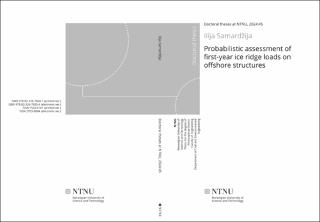| dc.contributor.advisor | Høyland, Knut Vilhelm | |
| dc.contributor.advisor | Næss, Arvid | |
| dc.contributor.advisor | Leira, Bernt Johan | |
| dc.contributor.author | Samardžija, Ilija | |
| dc.date.accessioned | 2024-01-17T07:27:55Z | |
| dc.date.available | 2024-01-17T07:27:55Z | |
| dc.date.issued | 2024 | |
| dc.identifier.isbn | 978-82-326-7693-4 | |
| dc.identifier.issn | 2703-8084 | |
| dc.identifier.uri | https://hdl.handle.net/11250/3112013 | |
| dc.description.abstract | Advancements in technological capabilities, growing energy demands, and climate change are making offshore regions with floating sea ice increasingly attractive for infrastructure development. Notable examples include the potential for hydrocarbon retrieval in the Barents Sea and offshore wind initiatives in the Bothnian Sea. In ice-covered seas, first-year ice ridges frequently impose the most significant loads on offshore infrastructure. Structures must be designed to withstand these loads with satisfactory reliability, while avoiding excessive conservatism to maintain the economic feasibility of the infrastructure projects.
Deterministic approaches for assessing ice ridge loads often result in overestimation of the design loads due to the necessity of assuming extreme values for several crucial input parameters, especially when data is sparse. In contrast, probabilistic methods present an opportunity for a less conservative assessment of ridge loads. The primary aim of this thesis is to lay the foundational framework, from both a scientific and engineering perspective, for methodologies that determine the structural reliability of offshore infrastructure in cold regions utilizing existing data. The focus is specifically on creating a probabilistic framework for modelling the loads of first-year ice ridges on fixed offshore structures.
This thesis explores the development of a method for the probabilistic simulation of input variables for ridge load calculations, ensuring the preservation of their significant correlations. The simulated variables should be unbiased and accurately represent the entire population of ice ridges over a season. Additionally, the research addresses the challenges of implementing this in regions with limited available data.
The study first focuses on long-term measurements of ice draft from the Beaufort Sea. From this data, individual ridge keel drafts, level ice thickness, and ridge frequency are extracted, and statistical analysis is used to establish relationships between these parameters. As anticipated from other studies, a positive relationship was found between level ice thickness and both ridge keel draft and ridge frequency. This study quantified these relationships in a way that is optimized for the probabilistic simulation of all ridges throughout a season while maintaining these relationships.
The study further combines ridge frequency data and theoretical analysis to simulate ridge creation and consolidated layer growth and to analyse the relationship between consolidated layer thickness and ridge keel draft. A negative relationship was observed between consolidated layer thickness and ridge keel draft, indicating that deeper ridges tend to have thinner consolidated layers.
The proposed probabilistic simulation model offers the advantage of requiring only annual maximum level ice thickness and information on the duration of the season and sea ice presence as input parameters, eliminating the need for data on ridge keel draft or consolidated layer thickness. As additional data is collected, the model can be further refined. This adaptability to diverse data availabilities enhances its applicability across various design stages, with the model's reliability increasing with more available data.
However, the model’s reliance on correlations from Beaufort Sea studies may limit its applicability to other seas, such as the Baltic Sea. Thus, for more accurate results, collecting long-term ice draft measurements and organizing field campaigns for consolidated layer thickness data are advisable. Future studies should explore recalibrating the established correlations between input variables for different regions. | en_US |
| dc.language.iso | eng | en_US |
| dc.publisher | NTNU | en_US |
| dc.relation.ispartofseries | Doctoral theses at NTNU;2024:45 | |
| dc.relation.haspart | Paper 1: Samardžija, Ilija; Høyland, Knut Vilhelm; Leira, Bernt Johan; Næss, Arvid. Probabilistic Assessment of Ice Environment and Ridge Loads for the Norströmsgrund Lighthouse. I: Proceedings of the 24th IAHR International Symposium on Ice Vladivostok, IAHR International Symposium on Ice 2018 s. 152-166 | en_US |
| dc.relation.haspart | Paper 2: Samardžija, Ilija; Høyland, Knut Vilhelm. Initial results of a study into the relationship between level ice draft and ridge keel draft. Proceedings - International Conference on Port and Ocean Engineering under Arctic Conditions 2019 ;Volum 2019-June | en_US |
| dc.relation.haspart | Paper 3: Samardžija, Ilija; Høyland, Knut Vilhelm. Analysis of the relationship between level ice draft, ridge frequency and ridge keel draft for use in the probabilistic assessment of ice ridge loads on offshore structures. Ocean Engineering 2023 ;Volum 270. https://doi.org/10.1016/j.oceaneng.2022.113593 This is an open access article under the CC BY license (http://creativecommons.org/licenses/by/4.0/). | en_US |
| dc.relation.haspart | Paper 4: Samardžija, Ilija; Høyland, Knut Vilhelm; Leira, Bernt Johan; Næss, Arvid. Consolidated layer thickness in probabilistic simulation of first-year ice ridges. Cold Regions Science and Technology 2023 ;Volum 216 https://doi.org/10.1016/j.coldregions.2023.104021 This is an open access article under the CC BY license (http://creativecommons.org/licenses/by/4.0/). | en_US |
| dc.relation.haspart | Paper 5:
Samardžija, I., Høyland, K. V., Leira, B. J., & Næss, A.
Probabilistic assessment of first-year ice ridge action on offshore structures. | en_US |
| dc.title | Probabilistic assessment of first-year ice ridge loads on offshore structures | en_US |
| dc.type | Doctoral thesis | en_US |
| dc.subject.nsi | VDP::Technology: 500::Environmental engineering: 610 | en_US |


